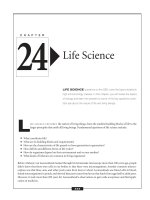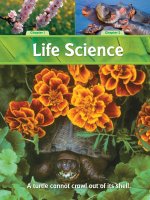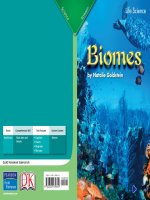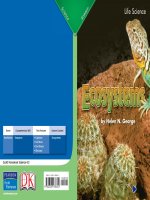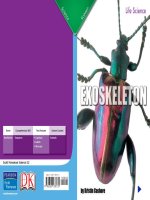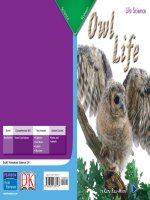exoskeleton life science
Bạn đang xem bản rút gọn của tài liệu. Xem và tải ngay bản đầy đủ của tài liệu tại đây (4.95 MB, 14 trang )
Scott Foresman Science 3.2
Genre Comprehension Skill Text Features Science Content
Nonfi ction Sequence • Captions
• Labels
• Glossary
Animals
ISBN 0-328-13813-4
ì<(sk$m)=bdibdf< +^-Ä-U-Ä-U
13813_01-04_CVR_FSD.indd Cover113813_01-04_CVR_FSD.indd Cover1 05/23/2005 20:30:1305/23/2005 20:30:13
Scott Foresman Science 3.2
Genre Comprehension Skill Text Features Science Content
Nonfi ction Sequence • Captions
• Labels
• Glossary
Animals
ISBN 0-328-13813-4
ì<(sk$m)=bdibdf< +^-Ä-U-Ä-U
13813_01-04_CVR_FSD.indd Cover113813_01-04_CVR_FSD.indd Cover1 05/23/2005 20:30:1305/23/2005 20:30:13
1. What types of animals have neither
endoskeletons nor exoskeletons?
What types of animals have both
endoskeletons and exoskeletons?
2. What are different ways in which an
exoskeleton might protect an animal?
3. Why are animals with exoskeletons
small? Why are sea animals with
exoskeletons able to grow bigger
than land animals with exoskeletons?
4.
In this book, you
have learned about sea animals that
have exoskeletons. Based on what
you have learned, write to explain
the differences between crustaceans
and mollusks. Use examples from
the book.
5.
Sequence In the correct order, list
the steps from birth to adulthood for
a damselfl y.
What did you learn?
Extended Vocabulary
bivalve
calcite
chitin
crustacean
echinoderm
endoskeleton
exoskeleton
gastropod
invertebrate
Vocabulary
adaptation
hibernate
inherited
larva
migrate
pupa
trait
vertebrate
Picture Credits
Every effort has been made to secure permission and provide appropriate credit for photographic material.
The publisher deeply regrets any omission and pledges to correct errors called to its attention in subsequent editions.
Photo locators denoted as follows: Top (T), Center (C), Bottom (B), Left (L), Right (R), Background (Bkgd).
3 (TR) Jerry Young/DK Images; 10 ©Jerry Young/DK Images; 11 (TR) ©Jerry Young/DK Images.
Scott Foresman/Dorling Kindersley would also like to thank: 8 (TR) Stephen Oliver/DK Images.
Unless otherwise acknowledged, all photographs are the copyright © of Dorling Kindersley, a division of Pearson.
ISBN: 0-328-13813-4
Copyright © Pearson Education, Inc. All Rights Reserved. Printed in the United States of America.
This publication is protected by Copyright, and permission should be obtained from the publisher prior to any
prohibited reproduction, storage in a retrieval system, or transmission in any form by any means, electronic,
mechanical, photocopying, recording, or likewise. For information regarding permission(s), write to
Permissions Department, Scott Foresman, 1900 East Lake Avenue, Glenview, Illinois 60025.
3 4 5 6 7 8 9 10 V010 13 12 11 10 09 08 07 06 05
13813_01-04_CVR_FSD.indd Cover213813_01-04_CVR_FSD.indd Cover2 05/23/2005 20:30:2205/23/2005 20:30:22
by Kristin Cashore
13813_05-28_FSD.indd 113813_05-28_FSD.indd 1 05/21/2005 11:37:1705/21/2005 11:37:17
Animals can be divided into vertebrates
and invertebrates.
A vertebrate is an animal with a backbone.
An invertebrate is an animal without a
backbone. Most animals are invertebrates.
The growth of every animal begins with
an egg. With insects like butterfl ies, a larva
hatches out of the egg. The larva then turns
into a pupa while preparing to
become an adult.
newly hatched ostrich
What You Already Know
2
13813_05-28_FSD.indd 213813_05-28_FSD.indd 2 05/21/2005 11:37:3405/21/2005 11:37:34
All animals are born
with adaptations. An
animal’s adaptations
are inherited from its
parents. Behavior is
an adaptation. For
example, some animals
are born with the
instinct to migrate or to
hibernate during winter. A trait is a body part,
type of behavior, or ability to learn a behavior
that an animal receives from its parents.
Fossils teach us about animals that lived long
ago. By studying fossils, we learn how animals
have changed over time.
In this book you will learn about an
invertebrate adaptation: the exoskeleton.
Animals with exoskeletons are all around us.
To fi nd out more about these animals,
keep reading!
European striped snail
3
13813_05-28_FSD.indd 313813_05-28_FSD.indd 3 05/21/2005 11:37:4905/21/2005 11:37:49
4
Skeletons
You know what a skeleton is. But have you
ever heard of an exoskeleton? What about
an endoskeleton?
An exoskeleton is a hard outer covering
that gives an animal strength and support.
An exoskeleton protects an animal’s soft inner
organs. Most invertebrates have exoskeletons
instead of bones to support their bodies and
protect their organs.
An endoskeleton is the frame of bones inside
vertebrates. This frame of bones protects their
organs and supports their bodies.
tiger endoskeleton
13813_05-28_FSD.indd 413813_05-28_FSD.indd 4 05/21/2005 11:37:5905/21/2005 11:37:59
5
Because most animals are invertebrates, most
animals have exoskeletons. Have you ever seen
a ladybug? Did you notice its hard, shiny wing
covers? Or maybe you have seen the shell of a
clam? The ladybug’s hard covering and the clam’s
shell are both exoskeletons. Insects, spiders,
centipedes, and millipedes have exoskeletons.
So do many sea animals, such as crabs, lobsters,
and shrimp.
Some animals don’t have
any type of skeleton! For
example, jellyfi sh have
neither an exoskeleton
nor an endoskeleton.
Their soft bodies can
change shape freely.
When a pillbug is in danger,
it will curl into a ball with
its exoskeleton facing out.
A jellyfi sh is an invertebrate, but
it does not have an exoskeleton.
13813_05-28_FSD.indd 513813_05-28_FSD.indd 5 05/21/2005 11:38:1205/21/2005 11:38:12
6
Your skin expands as you grow bigger. Most
exoskeletons do not expand. As an invertebrate
grows, it must shed its exoskeleton and form a
new one. This is called molting. Some
invertebrates molt many times during their lives.
Exoskeletons are hard. Despite their hardness,
most can fl ex in places to allow animals to move.
Exoskeletons are often heavy and thick. Animals
that have them tend to be small. The bodies of
most vertebrates would collapse if exoskeletons
were forced to support too large a body!
Animals with exoskeletons are found all over
the Earth. They live on the land, in the sea, and
also in streams and rivers.
Thanks to its green exoskeleton,
this mantis looks like a leaf!
13813_05-28_FSD.indd 613813_05-28_FSD.indd 6 05/21/2005 11:38:4005/21/2005 11:38:40
7
There are two kinds of animals that have both
endoskeletons and exoskeletons. Do you already
know which two animals they are?
Tortoises and turtles are vertebrates. Like other
reptiles, they have endoskeletons. But they also
have shells. Turtles and tortoises can pull their
heads, feet, and tails all the way into their shells.
Their shells serve as exoskeletons, protecting them
from their enemies.
The freshwater crayfi sh
lives in streams and rivers.
Crayfi sh have exoskeletons.
This side view of a
tortoise shows both
its endoskeleton and
its exoskeleton.
13813_05-28_FSD.indd 713813_05-28_FSD.indd 7 05/21/2005 11:38:5405/21/2005 11:38:54
8
Arthropods
The word arthropod means “jointed foot.”
Arthropod bodies have different sections,
and are covered by a jointed exoskeleton. The
joints allow the stiff exoskeleton to bend for
easier movement. Arachnids, insects, centipedes,
millipedes, and crustaceans are arthropods.
The exoskeleton of an arthropod is made of
a hard material called chitin. Chitin covers the
arthropod’s whole body, including its legs, eyes,
and antennae! Arthropods molt several times
before becoming adults.
The hair on a tarantula is actually
part of its exoskeleton.
millipede
13813_05-28_FSD.indd 813813_05-28_FSD.indd 8 05/21/2005 11:39:1305/21/2005 11:39:13
9
Many people think that spiders are insects.
But spiders are actually arachnids!
Arachnids are arthropods. They have eight
legs. Their bodies are made of two parts: the
head and the abdomen. Arachnids shed their
exoskeletons in order to grow.
Spiders need to rest right after shedding. But
if a spider does not fl ex its new exoskeleton, it
can become too hard. Spiders can even regrow a
missing leg by shedding!
Scorpions are also arachnids. Scorpions live in
warm, dry places, like deserts. They are bigger
than most spiders. Some scorpions grow to be
eight inches long! Scorpions have a sharp stinger
at the end of their tail that helps them catch
insects and small animals.
Careful! Do you see the
stinger on the tail of this
desert scorpion?
Arachnids
13813_05-28_FSD.indd 913813_05-28_FSD.indd 9 05/21/2005 11:39:3605/21/2005 11:39:36
10
Insects
Insects have six legs. Their bodies have three
parts: the head, the thorax, and the abdomen.
Insects’ exoskeletons do the same job as the
exoskeletons of arachnids. They protect and
support insects. Insects stay waterproof because
of their exoskeletons.
An insect’s muscles attach to the inside of
its exoskeleton. Insects may be tiny, but they
have many, many muscles. Have you ever seen an
insect carrying a piece of food many times larger
than itself? Insects are strong because of their
exoskeletons and muscles.
A male rhinoceros beetle uses
its horns to fi ght with other
males for a mate.
13813_05-28_FSD.indd 1013813_05-28_FSD.indd 10 05/21/2005 11:39:4705/21/2005 11:39:47
11
Locusts are insects
that sometimes move
in swarms.
When this ladybug begins
to fl y, it opens its wing
casings and stretches out
its wings.
Some insects have
very fancy exoskeletons.
A ladybug is usually
red, orange, or yellow
with black spots. Their
bright colors warn birds and
other insects that they taste
bitter. The color of their
exoskeleton protects them
from predators.
A rhinoceros beetle’s
exoskeleton is one of the fanciest! A male
rhinoceros beetle has horns that are strong
enough to pierce its rival’s exoskeleton. Many
beetles have spikes or horns built into their
exoskeletons.
13813_05-28_FSD.indd 1113813_05-28_FSD.indd 11 05/21/2005 11:39:5805/21/2005 11:39:58
12
Insects and Growth
Damselfl ies are born
underwater. A young
damselfl y, or nymph,
molts many times
while it is growing
underwater. Then one
day, it climbs out of the
water and molts for
the last time. When its
wings dry and its body
hardens, it is an adult.
Some insects go through many stages of growth
before becoming adults. Insects’ exoskeletons do
not expand or change. Because of this, an insect
cannot grow without shedding its exoskeleton.
When an insect becomes too big for its
exoskeleton, the exoskeleton cracks open.
The insect wriggles out and pulls away from
the old exoskeleton.
Damselfl y nymph holds
onto underwater stem.
Nymph sheds
skin while still
underwater.
12
13813_05-28_FSD.indd 1213813_05-28_FSD.indd 12 05/21/2005 11:40:1905/21/2005 11:40:19
13
After an insect has shed its exoskeleton, it can
take hours or even days for its new exoskeleton
to harden. During this time, the insect is soft and
unprotected, and cannot move much. If the insect
is lucky, it will remain safe until its new exoskeleton
has formed.
The insect’s new exoskeleton is bigger than the
last one. It is the right shape for this new stage of
the insect’s life. Most insects stop molting once
they are adults.
Nymph breaks away
from its old skin.
Young damselfl y moves
out of water and
continues to grow.
adult female
13
13813_05-28_FSD.indd 1313813_05-28_FSD.indd 13 05/21/2005 11:40:2505/21/2005 11:40:25
14
Sea Creatures
The oceans are full of invertebrates with
exoskeletons. Many sea animals, such as the
nautilus, have exoskeletons that grow into
beautiful shapes. The nautilus uses its shell for
protection. It also traps air in its shell, which
helps it fl oat in the water.
Water is much thicker than air. It gives more
support to sea animals. Because of this, sea
animals with exoskeletons can grow bigger than
animals with exoskeletons that live on the land.
Echinoderms, crustaceans, and mollusks
are all sea animals that have exoskeletons.
Echinoderms include starfi sh and sea urchins.
Crustaceans include crabs, lobsters, and shrimp.
Mollusks include clams, mussels, and oysters.
Let’s take a look at what each of these groups
is like, and how each group uses its exoskeleton.
13813_05-28_FSD.indd 1413813_05-28_FSD.indd 14 05/21/2005 11:40:3905/21/2005 11:40:39
15
A nautilus is a mollusk.
Its shell makes a very
strong exoskeleton!
A shrimp is
a crustacean.
13813_05-28_FSD.indd 1513813_05-28_FSD.indd 15 05/21/2005 11:40:4105/21/2005 11:40:41
16
Echinoderms
Starfi sh usually
have fi ve legs.
The word echinoderm (ik-EYE-nuh-derm)
means “spiny skin.” An echinoderm has a soft
body that is protected by a tough exoskeleton.
The exoskeleton is made of a hard material
called calcite. The exoskeleton is often spiny
and covered by a thin skin.
Starfi sh are echinoderms. Starfi sh have tiny
tubes for feet. The tubes work like suction cups,
and help move starfi sh around. Starfi sh also use
their tubes to pry open the shells of clams or
mussels. Starfi sh are very strong!
13813_05-28_FSD.indd 1613813_05-28_FSD.indd 16 05/21/2005 11:41:0205/21/2005 11:41:02
17
Sea urchins are also echinoderms. Their
exoskeletons are covered with spines, which
protect them from predators. The spines fi t onto
little bumps on the sea urchins’ bodies. Sea
urchins are able to rotate their spines in every
direction around these bumps. Like starfi sh,
sea urchins move by using tiny, tubelike feet.
The parts of a sea urchin are
arranged around its center,
like the slices of an orange.
13813_05-28_FSD.indd 1713813_05-28_FSD.indd 17 05/21/2005 11:41:1305/21/2005 11:41:13
18
Crustaceans
Crustaceans (kruh-STAY-shuns) are arthropods
that live in the ocean. Crabs, lobsters, crayfi sh,
shrimps, krill, and barnacles are crustaceans.
As with other arthropods, the exoskeletons
of crustaceans are made of chitin. A crustacean
has joints in its exoskeleton, which allows it to
move around. The legs of a crustacean are narrow,
with a number of fl exible joints. This helps it
to walk.
Some crustaceans move around a great deal.
There are even crustaceans that migrate! For
example, some lobsters migrate to deeper water
during the winter.
The exoskeleton on the back of a velvet crab
is covered with velvety fuzz.
13813_05-28_FSD.indd 1813813_05-28_FSD.indd 18 05/21/2005 11:41:2105/21/2005 11:41:21
19
Look out! A lobster’s claws
are very strong and fast.
Lobsters move in long, straight lines when
they migrate. Many fi shermen call this the
“lobster march.”
Like other arthropods, crustaceans have
muscles which attach to the inside of their
exoskeletons. Also like other arthropods,
crustaceans must shed their exoskeletons in
order to grow. Crustaceans grow to be bigger
than most other arthropods because the water
gives them extra support.
13813_05-28_FSD.indd 1913813_05-28_FSD.indd 19 05/21/2005 11:41:3105/21/2005 11:41:31
20
Mollusks
A mollusk is an animal with a soft body that
usually has a shell. The shell is the mollusk’s
exoskeleton. Mollusks do not molt.
Some mollusks are gastropods. A gastropod
usually has one big foot that helps it crawl along.
It also usually has a curved shell that covers
its soft body, and a head with eyes and
tentacles. Snails, conches, and
whelks are gastropods.
The yellow and pink
mollusks are dog whelks.
See the cluster of black
shells? These are mussels.
13813_05-28_FSD.indd 2013813_05-28_FSD.indd 20 05/21/2005 11:41:4305/21/2005 11:41:43
21
Queen scallops can grow to be
three and a half inches across.
Other mollusks are bivalves. Bivalves have
a soft body with no head. They are protected
by their shells, which are formed in two parts.
A hinge holds the two parts together. Mussels,
oysters, clams, and scallops are bivalves.
Scallops move by squirting water from their
shells. It’s a funny way of getting around! If a
scallop is in danger, its shell closes quickly.
The shells of mollusks are made from a
material rich in calcium. They are extremely
strong and diffi cult to break. As a mollusk
grows, its shell grows with it.
13813_05-28_FSD.indd 2113813_05-28_FSD.indd 21 05/21/2005 11:41:5605/21/2005 11:41:56
22
Animal Bodies
Inside and Out
Every animal needs some kind of support, so
that it can keep its shape, move, and protect itself.
You get your support from your bones, but most
animals get their support from exoskeletons.
Beetles, scorpions, starfi sh, lobsters, snails, and
oysters all have exoskeletons. Everywhere you
look you can fi nd animals with exoskeletons!
sea urchin shells
13813_05-28_FSD.indd 2213813_05-28_FSD.indd 22 05/21/2005 11:42:0805/21/2005 11:42:08
23
Some exoskeletons are
like a hard skin, and others
are shells. Some must be shed
so that an animal can grow, and
others grow with the animal.
Some are fl exible, and some
don’t move at all. Some are
colorful, and some are dull.
Exoskeletons have one thing in
common. All exoskeletons are adaptations that
invertebrates have. This is because exoskeletons
allow most of the world’s animals to live
and thrive!
black widow
spider
leaf beetle
13813_05-28_FSD.indd 2313813_05-28_FSD.indd 23 6/1/05 11:32:07 AM6/1/05 11:32:07 AM
24
Glossary
bivalves mollusks with no head and a shell
in two parts connected by a hinge
calcite the hard material that forms the
exoskeleton of an echinoderm
chitin the hard material that forms the
exoskeleton of an arthropod
crustaceans arthropods that are sea creatures.
A few crustaceans live in freshwater
echinoderms sea creatures with soft inner bodies
and tough outer shells
endoskeleton the frame of bones inside
a vertebrate
exoskeleton the hard outer covering around
most invertebrates
gastropod a mollusk with one big foot,
usually a curved shell, and a head
with eyes and tentacles
invertebrate an animal that does not have
a backbone
13813_05-28_FSD.indd 2413813_05-28_FSD.indd 24 05/21/2005 11:42:2905/21/2005 11:42:29
1. What types of animals have neither
endoskeletons nor exoskeletons?
What types of animals have both
endoskeletons and exoskeletons?
2. What are different ways in which an
exoskeleton might protect an animal?
3. Why are animals with exoskeletons
small? Why are sea animals with
exoskeletons able to grow bigger
than land animals with exoskeletons?
4.
In this book, you
have learned about sea animals that
have exoskeletons. Based on what
you have learned, write to explain
the differences between crustaceans
and mollusks. Use examples from
the book.
5.
Sequence In the correct order, list
the steps from birth to adulthood for
a damselfl y.
What did you learn?
Extended Vocabulary
bivalve
calcite
chitin
crustacean
echinoderm
endoskeleton
exoskeleton
gastropod
invertebrate
Vocabulary
adaptation
hibernate
inherited
larva
migrate
pupa
trait
vertebrate
Picture Credits
Every effort has been made to secure permission and provide appropriate credit for photographic material.
The publisher deeply regrets any omission and pledges to correct errors called to its attention in subsequent editions.
Photo locators denoted as follows: Top (T), Center (C), Bottom (B), Left (L), Right (R), Background (Bkgd).
3 (TR) Jerry Young/DK Images; 10 ©Jerry Young/DK Images; 11 (TR) ©Jerry Young/DK Images.
Scott Foresman/Dorling Kindersley would also like to thank: 8 (TR) Stephen Oliver/DK Images.
Unless otherwise acknowledged, all photographs are the copyright © of Dorling Kindersley, a division of Pearson.
ISBN: 0-328-13813-4
Copyright © Pearson Education, Inc. All Rights Reserved. Printed in the United States of America.
This publication is protected by Copyright, and permission should be obtained from the publisher prior to any
prohibited reproduction, storage in a retrieval system, or transmission in any form by any means, electronic,
mechanical, photocopying, recording, or likewise. For information regarding permission(s), write to
Permissions Department, Scott Foresman, 1900 East Lake Avenue, Glenview, Illinois 60025.
3 4 5 6 7 8 9 10 V010 13 12 11 10 09 08 07 06 05
13813_01-04_CVR_FSD.indd Cover213813_01-04_CVR_FSD.indd Cover2 05/23/2005 20:30:2205/23/2005 20:30:22
